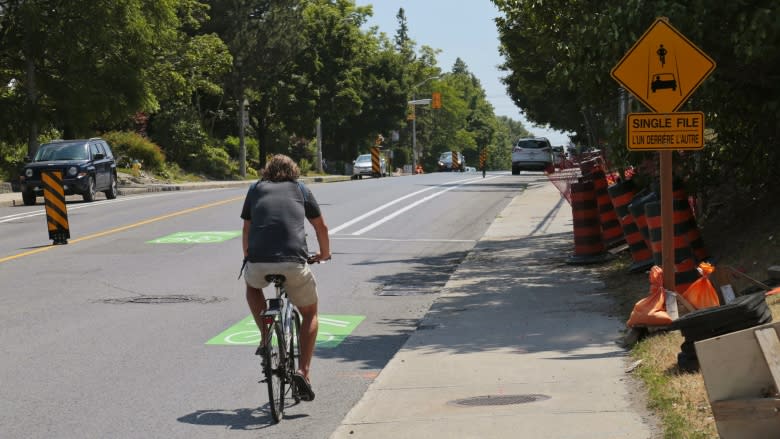Drivers slam bridge detour as city defends shared route
Cyclists aren't the only ones slamming the city's new Harmer Avenue bridge detour.
Drivers say they worry the shared route will anger other impatient motorists and endanger the safety of cyclists.
As a driver, John Salvatore says he understands that more and more cyclists are on the road, but he says not everyone behind the wheel is as considerate.
"I find it's dangerous, because most drivers don't have the patience to stay behind the cyclists," he said.
"Who wants to admit that there's a little bit of frustration there in terms of your speed."
The City of Ottawa has already lowered the speed limit to 30 km/h along the 500-metre detour route, which runs from Byron Avenue to Kenilworth Street near the Civic campus of the Ottawa Hospital.
The new design relies on super-sharrows: green markings set in the middle of the road.
The idea is to encourage cyclists to "take the lane" by riding on top of the sharrows, with drivers supposed to follow in a single file.
Despite center posts set in the middle of the road, some drivers have taken to veering into the opposite lane to pass cyclists riding over the sharrows.
'A false sense of security'
Gary Longchamps is part of the Friends of Holland Avenue, the community group that successfully petitioned the city to abandon the initial plan for a segregated bike lane.
Although he's glad the city maintained parking along the road, he says the super-sharrows model will endanger cyclists.
"Cyclists are being lulled into a fall sense of security," he said, citing past cycling deaths along Laurier Avenue W. and Riverside Drive.
"You can't trust the drivers. You might get hit and you'll come out the loser."
Worried parents
It's that prospect of an accident that has parents like Jennifer Skuce worried.
"My daughter goes to Fisher Park [middle school]. The idea of her taking her bike down from our house down Holland doesn't thrill me," she said.
"Sharing a lane with cars and bikes is, I think, a ridiculous option."
Kitchissippi ward Councillor Jeff Leiper has been pushing the city to go back to the drawing board with the Harmer Avenue bridge detour.
Leiper's preferred plan would be to build a segregated bidirectional bike lane on one side of Holland Avenue — similar to what's in place on O'Connor Street in the city's downtown.
Debate over segregated lanes
That proposal is raising safety concerns of its own.
Alayne McGregor, a longtime cycling advocate and past president of Citizens for Safe Cycling, says a segregated bike lane would only make things worse on Holland Avenue.
"There just isn't enough space to put that bike lane there and it would also likely cause collisions," she said.
McGregor is especially concerned that residents might block the bike lane when arriving or leaving their home.
The sloped southern section of the detour near Kenilworth Street could also cause problems with cyclists, she said.
Instead, McGregor hopes to see tweaks to the current design, including the removal of the center posts to make it easier for drivers to pass, as well as the possibility of temporarily raising intersections to reduce drivers' speed.
City defends detour setup
Meanwhile, city officials are standing by the detour's design.
Greg Kent, manager of traffic management with the City of Ottawa, downplayed safety concerns, saying that cyclists and drivers should both expect a learning curve.
"The cars will get used to those cyclists and the cyclists will get used to where they want to cycle," he said.
Kent noted that cyclists can ride either in the middle of the lane or off to the side of the lane, although cyclists have said that second option leaves them more vulnerable to dooring.
The city is also allowing cyclists to ride on the sidewalk on the west side of Holland along the detour route, he said, provided they yield to pedestrians.
"All pieces considered — in terms of putting things into play and all the different users — it's a safe operation," Kent said.
The city will monitor the detour and could make tweaks to signage, markings and enforcement, Kent said, adding that the city is also studying the idea of a fully protected lane.
The detour itself is set to stay in place for two years.





